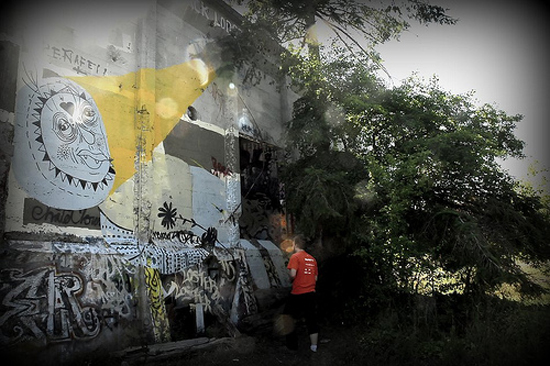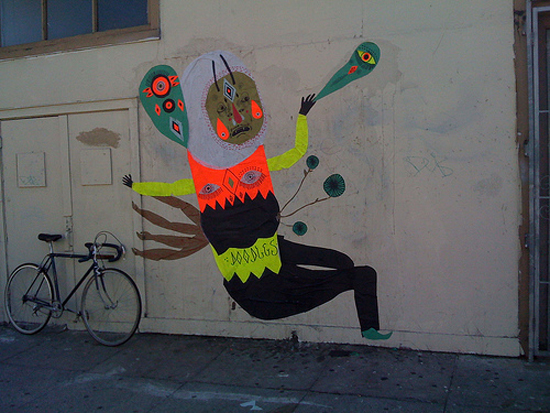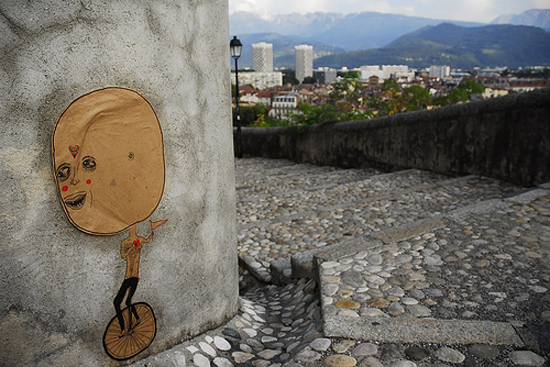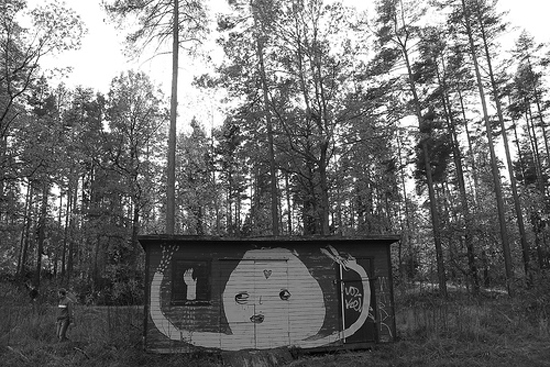SpearTalks: Doodles

According to some, the streets are at a crossroads. Not long ago, the art covering the bricks and blank spaces of the city was more likely to get you in trouble than in Christie's, but today's take leans more towards halos than handcuffs. This shift can partially be attributed to the quality of today's work (and the hype that surrounds it) but also, strangely enough, to the financial opportunities that have arisen within graffiti. No matter the game, the rules change when money and fame join the party — and they've certainly started to party with street art.
In order to suss out if these fears had a foundation, we decided to take a sit with Doodles, a 20-year-old out of the Bay Area who we consider a member of the "˜new school' of street artists. He also happens to be in school, adding another interesting element to our interview. Say hello to the future of graf art, readers — it's looking good.

Joshspear.com: Here it is, the obligatory “tell us about yourself” question. Care to share?
Doodles: Hi. I'm a 20 year-old artist living in Oakland, CA who goes by the nickname “doodles.” I grew up in the Seattle area, then moved to the bizarre city of St. Petersburg, Florida for two years to pursue the study of marine biology. St. Petersburg’s severe lack of young culture gave me the motivation to focus on more creative projects. After a year and a half, I put a stop on my marine science dreams and decided to focus on art. That said, I still love narwhals, giant squid, manatees, and lobsters.
I currently go to California College of the Arts in Oakland, where I am pursuing a degree in community arts.
I enjoy hiking, exploring, biking, camping, traveling, playing guitar, bouzouki, drums, cooking foods, building forts, swimming, picnics, SCUBA-diving, talking to new people, taking baths, reading, and the creation of art.
JS: You do a lot of great non-street art work. Which came first, the street or the studio?
D: Placing work in the street was one of the earlier things that I focused on. When I was younger, I played in a lot of bands and made lots of flyers for shows.
Creating flyers was a great way for me to channel my creative energy into something that was visual. My friends and I would make hundreds of free copies at our high school and just post an obscene amount of flyers throughout our town. I really enjoyed the act of placing something I created in public space. It also evoked the mischievous nostalgia of childhood pranks like ding-dong ditching…
From there I became interested making stencils. I couldn’t draw well at the time, and stencils allowed me to create images without using pen and paper. I'd spray the stencils at an abandoned lumber mill building in my town, and I also did a few in Seattle.
I became better at drawing the more and more that I did it. Eventually I learned to love drawing, and the techniques that I had learned on my own translated over to the work that I was doing in the streets. That's when I started to paint walls without stencils, and also create images on paper for wheatpasting. Now I try to focus on finding a balance between my studio and street work.

JS: You’re actually the first street artist I’ve talked to that’s currently in art school. Being so early in your 20’s, you’ve probably grown up in a bit of a different world as far as street art is concerned — what’s the attitude about it like among faculty?
D: I'm only in my first month of art school, so it's hard for me to grasp what the general consensus is in regards to street art. Certain faculty members seem to support the practice of illegal art and have talked about The Billboard Liberation Front, Swoon, Ron English and Banksy in some classes. In the community arts program, the curriculum draws many parallels with street art in the sense that it focuses on placing art in public venues other than the “white cube.” Some community arts professors especially stress the importance of the legal and illegal interaction that occurs on public space.
JS: It must feel good to know that your work has been posted on Wooster Collective — was that piece you did in SF the first one that they featured?
D: The piece that they featured in San Francisco was not the first of mine to be on Wooster Collective. About two years ago, I did a smaller wheatpaste character in Florida that they featured. I feel honored to be featured among artists like blu, Sam3, Ericailcane, Swoon….
JS: The art scene in the San Francisco area is different than it is in Seattle. There’s tons of great talent in both places, but in SF do you find that it’s more intimidating to put up your work, or is it actually a better environment?
D: I find that it is more intimidating to place work in the streets of San Francisco because I’m new to the area. In Seattle, I know where more spots are and I’m more familiar with the city’s layout. Also, I know more street artists in Seattle, which is nice. San Francisco is a city with a huge history of graffiti, which makes its environment more positive for public art. Also, the mission district is home to a ton of beautiful murals. Although it is still a great area to find graf and street art, I find that my work doesn’t do the other pieces justice.

JS: I was recently chatting with The Dark, a great artist out of Vancouver, and he had some interesting thoughts on how the popularity behind wheatpasting and stenciling has really introduced some scary elements into the game — stuff like more desire for fame and money than just to create. Do you think there’s any truth to those fears?
D: I find that statement true in the sense that certain artists are using wheat pasting in an inappropriate way. Obey (Shepard Fairey) has been using his posters as promotion for Barack Obama, but I find this dangerous because he initially captured counter-culture's attention with his anti-big brother poster campaign. Now he is promoting a candidate who represents some big brother qualities. Corporate media and the Council on Foreign Relations already promote and fund Obama. This element of the controlled left’s promotion of corporate politicians should not exist in street art and graffiti. When what’s popular on TV and corporate America starts showing up in the streets, I find that it looks more like advertising and less like art. Our communities are already littered with abhorrent amounts of advertising. There is no need for more.
JS: There are some crazy things in the ocean — does your thing for sea-life inspire your artistic style?
D: Yes, it definitely does, however I’ve been drifting away from it in the past year or so. I used to draw narwhals a lot. They are the unicorns of the sea, which makes them especially appropriate subjects for art-making. I would like to integrate more ships, canoes, and sea creatures into my work in the near future, and I'd also like to paste/paint in industrial waterfront areas where sea-life used to be more prevalent.
JS: Tell us about the zine you work on…
I recently finished a zine called “Cocoon” that I finished during an artist residency this summer on Pender Island, British Columbia at an awesome place called Islands Fold. It's a collection of drawings that are inspired by illusions and the natural beauty of the Pacific Northwest. You can get it at islandsfold.com
I also created a zine called “Northwest Zest” that documents Seattle street art. The first issue features interviews with Claudius Phaedrus and Baldman, as well as a feature on Parskid. Unfortunately, I don’t think that I can continue the zine because I live in the Bay Area now.
JS: Dream location for your next wheatpaste?
D: South America, or the moon.
